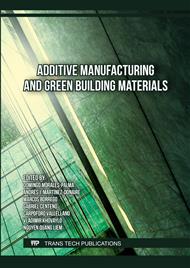p.23
p.33
p.41
p.51
p.61
p.71
p.81
p.91
p.99
Porosity Reduction in 15CDV6 Steel Manufactured by L-DED
Abstract:
The Laser Directed Energy Deposition (L-DED) is an Additive Manufacturing process based on the direct injection of the filler material into the desired areas of a substrate. Damaged components can be repaired or coated in order to enhance their properties and increase their lifespan. However, this process is highly material dependent and to assure the quality of the deposited material, the process parameters need to be optimised. In the present work, a novel material for the L-DED is developed, the 15CDV6 aeronautical steel. The material was atomized ad hoc and the obtained powder was characterized (particle shape, size distribution, and chemical composition) in order to ensure its quality. Once the powder was analysed, the suitability of the 15CDV6 steel for the L-DED process was studied through a methodology consisting of three sequential steps: single clad tests, layer deposition and wall construction. The main process parameters (laser power, feed rate and powder feed rate) were controlled during these tests. Nevertheless, the initial tests showed high levels of porosity, which required considering additional process parameters to reduce them, such as the carrier and shielding gas flows, preheating, or the laser beam diameter. Consequently, the porosity formation mechanisms were identified and the most relevant process parameters established, which for the 15CDV6 steel were the gas flows. The effect of the shielding gas flow in the powder distribution below the nozzle was studied experimentally by digital image analysis to better interpret the obtained results and determine the optimum process parameters for achieving defect free parts. The quality of the deposited material was studied through metallographic analysis and an Acicular Ferrite structure was observed, ensuring good mechanical properties. To summarise, this research work proves the viability of employing 15CDV6 steel in the L-DED process and has determined the main process parameters to obtain porosity-free parts.
Info:
Periodical:
Pages:
61-69
Citation:
Online since:
September 2023
Keywords:
Price:
Сopyright:
© 2023 Trans Tech Publications Ltd. All Rights Reserved
Share:
Citation:



